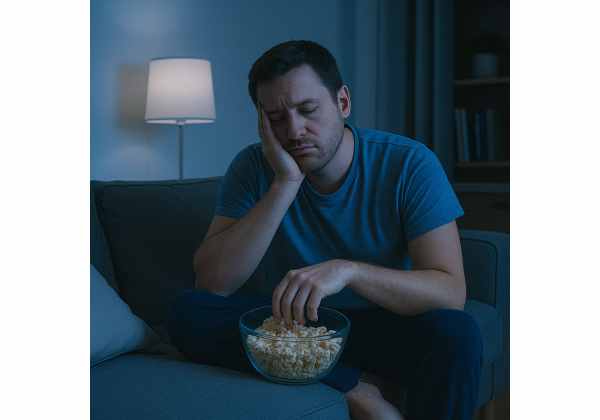
Evenings can stretch long. Work is done, energy dips, and the kitchen sits nearby. Many people eat at night not from hunger but from habit, emotion, or simple boredom. You can change that pattern without harsh rules. This guide gives you a precise plan to prevent grazing, build a calming routine, and keep satisfying options ready when you truly need a snack. If you want broader skills that strengthen results—sleep, stress tools, and simple systems—start with our practical habits-first approach, then return to these night strategies.
Table of Contents
- Why boredom eating at night happens
- Stop it tonight: 20-minute plan
- Build an evening routine that works
- Food environment and smart swaps
- Mindset, emotions and stress
- Special situations: shifts, family, travel
- Track progress and stay consistent
- Frequently Asked Questions
Why boredom eating at night happens
Night eating is rarely about food alone. It is about cues, gaps, and states.
- Cues: You sit on the couch with a show, pass the pantry on the way to bed, or clear dishes and sample leftovers. The environment prompts nibbling.
- Gaps: Skipped protein at lunch, a tiny dinner, or long stretches between meals leave you under-fueled. The body asks for quick energy when the day slows.
- States: Fatigue, stress, loneliness, or boredom heighten craving for fast comfort. Screens stimulate, then keep you awake, which extends the window for snacking.
Understanding your pattern helps you build a targeted fix. Start by mapping time, trigger, and food for the last week. Most people find one to two repeat moments: 8:30 p.m. on the couch, or 10:15 p.m. while doing dishes. Your plan will target those minutes, not the entire evening.
Mechanisms you can influence
- Hunger regulation: Protein at meals (25–35 g), fiber-rich sides, and planned snacks reduce late-night drive. Hydration also matters; mild dehydration is often felt as “snacky.”
- Sleep pressure: A consistent wind-down and darker lighting increase sleepiness and reduce grazing. When bedtime slides later, intake tends to rise.
- Decision fatigue: By night, willpower is low. Pre-deciding a snack list and creating friction for impulsive foods make the easy choice the supportive one.
What this article will help you change
- Timing: When and how you eat earlier so nights are quieter.
- Environment: What sits visible versus out of sight.
- Scripts: What you do the moment the urge hits.
- Options: Satisfying choices for genuine hunger.
If you are rebuilding fundamentals for broader goals, revisit calorie awareness, protein targets, and movement basics in our concise weight loss basics to see how night strategies fit the bigger picture. You do not need perfection. You need a repeatable plan that works on normal days.
Two quick truths to keep in mind
- One late night does not undo progress; repeating it nightly does. Aim for five steady nights out of seven.
- Boredom eating shrinks when evenings feel structured. You are designing a calmer night, not policing yourself.
Stop it tonight: 20-minute plan
Use this immediate, one-evening protocol to interrupt boredom eating tonight. Set a timer for 20 minutes and work through the steps.
Minute 0–3: Name the urge and pause
- Say out loud: “This is a boredom urge. It will peak and pass.”
- Drink 300–500 ml of water or herbal tea.
- Start a 10-minute timer. During the timer, do anything non-food: shower, quick tidy, text a friend, stretch.
Minute 4–7: Check the hunger signal
Ask: “When did I last eat a balanced meal?” If it has been 4+ hours or dinner was light, you may be hungry. Use one of these green-zone snacks (ready in under two minutes):
- Greek yogurt with frozen berries
- Cottage cheese with cherry tomatoes and pepper
- Apple or pear with 1 tbsp peanut butter
- Two rice cakes with hummus and turkey
- Microwave popcorn (light) measured to a bowl
If you are not hungry but still want to eat, you are in urge territory. Keep going.
Minute 8–12: Change the scene
- Brush teeth and floss. Mouth feel matters.
- Dim living room lights; switch the bright kitchen light off.
- Put remotes or controllers in another room for a moment. Stand up and walk a short lap or stomp stairs twice.
Minute 13–16: Choose a “tiny task”
- Fold five items of laundry, water plants, or set out tomorrow’s breakfast dishes.
- Or step outside for five minutes of fresh air. State change reduces rumination.
Minute 17–20: Decide deliberately
- If still hungry, plate a single planned portion (e.g., yogurt bowl or fruit with peanut butter) and sit to eat it slowly.
- If not hungry, make a comfort choice that is not food: warm shower, a favorite short video, a book chapter, or guided breathing.
Optional: Lock the kitchen
- Close the pantry and fridge with a visible elastic band or ribbon at night. The visual cue reminds you the kitchen is “closed.”
- Leave a sticky note on the fridge: “Tea first.”
What success looks like tonight
- You paused the first impulse.
- You ate a green-zone snack only if hungry.
- You ended the evening with teeth brushed and a calmer body state.
Repeat this mini-protocol for three nights. Most people notice urges feel shorter by night four or five. If you want deeper strategies to stop repeated night eating patterns, explore our focused playbook for late-night snacking after you test the 20-minute plan.
Build an evening routine that works
Consistency comes from design, not discipline. Build a short routine that makes the default behavior supportive—even on tired days. Aim for a 60–90 minute wind-down window most nights.
1) Set anchor points
- Kitchen close-down: After dinner dishes, wipe counters, start the dishwasher, and put a mug and tea bag by the kettle. This marks “cooking is done.”
- Teeth brushing as a boundary: Brush right after tea. People eat less after mint and freshness.
2) Design the sequence
Use a stacked routine that flows:
- Start kettle → drink a glass of water.
- Brew herbal tea → tidy a small area for five minutes.
- Brush teeth → phone to night mode and charge outside the bedroom.
- Dim lights → open a book or stretch for ten minutes.
If you are new to building routines, our simple guide to a stronger bedtime routine can help you pick steps that cue sleep and reduce cravings.
3) Choose a “third place” activity
Boredom eating thrives when the only evening activity is screens. Add one hands-busy, mind-light activity that occupies the window when you usually graze:
- Puzzles, crosswords, or crafts
- Light stretching or foam rolling
- A slow walk call with a friend
- Shower plus skincare routine
4) Protect sleep pressure
- Aim for a stable wake time; sleep pressure builds from the morning forward.
- Reduce intense light after 9 p.m. Consider night mode on devices and lamps instead of overheads. Even small changes help.
- Caffeine timing matters. Stop 6–8 hours before bed.
5) Plan tomorrow’s first meal
Set out a protein-forward breakfast component (eggs, yogurt, tofu scramble fixings). Knowing breakfast is easy reduces the urge to “stock up” on calories at night.
6) Build a movement micro-habit
A 10-minute walk after dinner or simple stair laps support digestion and mood. If the weather is poor, walk hallways or do a short mobility routine.
7) Create if-then rules
- If I want dessert, I will plate a small portion and sit down to eat it slowly.
- If I am still thinking about food after dessert, I will start the tea timer and read for ten minutes before deciding anything else.
A routine that you enjoy is one you keep. Build it around what calms you, not what impresses anyone. The goal is a night that quietly lands you in bed, not a perfect checklist.
Food environment and smart swaps
You cannot out-argue your environment every night. Make it easier to eat well when bored by changing visibility, friction, and availability.
Visibility: what you see first
- Put green-zone snacks (yogurt, cottage cheese cups, fruit, cut vegetables, hummus, popcorn kernels) at eye level in the fridge and pantry.
- Move high-temptation foods to opaque bins on higher shelves. Keep family favorites, but change who they are visible to.
Friction: a tiny speed bump
- Keep treats in single-serve formats or portion into small containers (e.g., 20–30 g nuts, one mini chocolate).
- Use smaller bowls for desserts and snacks. The first serving looks generous; the second requires a deliberate choice.
Availability: always-ready protein and fiber
- Stock cooked proteins (chicken, tofu, lentils) and washed vegetables weekly.
- Keep frozen berries, steam-in-bag vegetables, and pre-cooked rice cups for quick bowls.
Smart night swaps
- Chips → air-popped popcorn (2–3 cups) with a sprinkle of Parmesan.
- Ice cream pint → yogurt bark (Greek yogurt with berries and a few chocolate chips, frozen and broken into pieces).
- Candy bar → Greek yogurt mixed with a teaspoon of cocoa and berries.
- Cheese and crackers → apple slices with 1 tbsp peanut butter or rice cakes with hummus and turkey.
Portion cues that help
- Serve snacks in bowls, not from packages.
- Eat seated, not standing at the counter.
- Plate fruit or yogurt before you take out anything richer.
Prep in 15 minutes each Sunday
- Wash and bin fruit and vegetables.
- Boil a dozen eggs; peel half.
- Pre-portion nuts and popcorn kernels.
- Cook one batch of lentils or chicken for quick bowls.
If you want a fuller kitchen makeover that quietly guides choices all week, use the tactics in our detailed food environment reset. Night urges shrink when the first thing you see is the thing you actually intend to eat.
Mindset, emotions and stress
Boredom eating is often a stand-in for unmet needs: stimulation, comfort, connection, or relief. Bringing those needs into focus reduces the pull of the pantry.
Name the state accurately
Say it clearly: “I am bored,” “I feel lonely,” or “I need to decompress.” Accurate labels point to better actions than “I am just hungry.”
Create a non-food comfort menu
Pick two to three options that soothe quickly:
- Warm shower or bath
- Weighted blanket for ten minutes
- Text a friend or send one voice message
- Short breathing drill (four seconds in, six out for two minutes)
Use the urge surfing technique
Imagine the craving like a wave: it rises, peaks, and falls. You do not need to fight it; you ride it. Set a 10-minute timer, breathe slowly, and watch the intensity drop. Then decide.
Reduce self-talk that fuels binges
Replace “I blew it” with “I had more than planned; my next decision is water and bedtime.” Language moves behavior.
Add friction to rumination
Keep a notebook in the kitchen drawer. When the urge hits, jot three lines:
- What happened before the urge?
- What do I actually need?
- What will I try for ten minutes?
Writing slows the loop and clarifies your next move.
If emotions run hot
Have a fast exit: step onto the balcony, into the hallway, or do ten squats. Physical state shifts mental state.
When deeper patterns show up
If eating numbs strong feelings often, pair these tools with professional help. A therapist can help you build other coping skills. For targeted work on emotion triggers, review our concise guide to identifying and breaking emotional eating cycles and choose one exercise to practice this week.
Special situations: shifts, family, travel
Your plan needs to survive your real life. Adapt these strategies to unique schedules and households.
Shift work
- Event anchors, not clock times: Tie snacks to clock-in, handover, or arrival home.
- Pre-sleep mini meal: Protein + fiber (Greek yogurt and fruit, cottage cheese and tomatoes) before daytime sleep reduces wake-ups to snack.
- Light control: Use blackout curtains and an eye mask to increase sleep pressure and cut overnight grazing.
For a deeper plan that includes meal timing and schedule templates, see our guide for shift workers.
Families and roommates
- Create zones: shared snacks visible; personal treats in labeled opaque bins.
- Plate your food first using the ½ veggies, ¼ protein, ¼ starch template before serving others.
- Set a house cue: tea and small plates after dishes. It signals “kitchen is closed” without a lecture.
Travel nights
- Pack an “evening kit”: herbal tea, a shelf-stable protein (jerky, tuna pouch), and fruit.
- On hotel nights, buy yogurt, fruit, and seltzer at check-in. Decide dessert once at dinner; avoid grazing in the room.
Stressful weeks
- Use the minimum viable plan: one protein at each meal, one vegetable daily, one 10-minute walk. Lower the bar; keep consistency.
Medication and conditions
- If you take medicines that affect appetite or blood sugar, coordinate snack timing with your clinician. Protecting stable meals usually calms night urges.
Cultural and social traditions
- Keep the ritual, reduce the repetition. Enjoy the special item mindfully once; avoid looping back to the snack table. Sit farther from food and closer to conversation.
Your plan is a framework, not a cage. Make small, respectful adjustments that protect your goals and fit your people.
Track progress and stay consistent
Measurement keeps you honest and flexible without obsession. Track behaviors that drive results, not just the scale.
Choose two lead measures
- Nights without unplanned eating (aim for 5 of 7)
- Green-zone snacks used versus impulsive snacks
- Protein targets hit (25–35 g at dinner)
- Lights dimmed and teeth brushed by a set time
Use light-touch lag measures
- Weekly weight trend: same day, same time, similar clothing. Look for direction over weeks, not day-to-day blips.
- Waist measurement once every two weeks.
Create a weekly review (10 minutes)
- Wins: what worked three times or more?
- Sticking points: where did the urge win?
- Edit the system: move a snack to eye level, shift dinner protein, or set a new tea reminder.
Accountability that suits you
- Text a friend a simple “tea and brush” emoji check each night.
- Use a habit app and celebrate streaks, not perfection.
- If scale anxiety is high, use trend-only views or focus on behavior counts. Short, sane check-ins maintain momentum.
Lapse versus relapse
A lapse is a single night. A relapse is a pattern. Your reset protocol is simple:
- The next morning: water, protein-forward breakfast, 10-minute walk.
- That night: reinstall the 20-minute plan and close the kitchen after tea.
Keep the floor high
Your “floor” is what you do on the worst day. Define it now: one balanced dinner, tea after dishes, and phone to night mode by 10 p.m. A high floor beats a high ceiling that collapses.
Frequently Asked Questions
Is boredom eating at night the same as night eating syndrome?
No. Boredom eating is situational and tied to habits or low stimulation. Night eating syndrome involves recurrent nocturnal eating with sleep disturbance and morning appetite loss. If you wake to eat several times weekly, speak with a clinician for assessment and support.
Should I stop eating after a certain time?
Set a kitchen close routine rather than a hard curfew. After dinner, brew tea, brush teeth, and dim lights. If you are hungry later, choose a planned protein + fiber snack. Rigid cutoffs can backfire; routines are more sustainable and flexible.
What is a good late snack if I am truly hungry?
Pick protein + fiber options: Greek yogurt with berries, cottage cheese with tomatoes, or an apple with peanut butter. These satisfy quickly and prevent grazing. If you still want dessert, enjoy a small portion plated and seated, not from the package.
Does lack of sleep make boredom eating worse?
Yes. Short or erratic sleep elevates appetite and cravings, then extends awake time for snacking. Protect a steady wake time, limit evening bright light, and stop caffeine 6–8 hours before bed. A consistent wind-down often reduces night grazing within a week.
How do I stop snacking while watching TV?
Change the scene and routine: keep snacks off the coffee table, hold a fidget or hot tea during shows, and pause the episode midway for a five-minute stretch break. If you still want food, use a green-zone snack in a bowl, then brush teeth.
Will skipping dinner help reduce night eating?
Skipping dinner usually backfires. You arrive to the evening hungry and primed to graze. Eat a balanced dinner with 25–35 g protein, vegetables, and a small starch. If you prefer lighter, add a planned protein snack later rather than foraging.
References
- The role of insufficient sleep and circadian misalignment in obesity (2022) (Review)
- Late isocaloric eating increases hunger, decreases energy expenditure, and modifies metabolic pathways in adults with overweight and obesity (2022) (RCT)
- Caffeine Effects on Sleep Taken 0, 3, or 6 Hours before Going to Bed (2013) (RCT)
- An Updated Review of Night Eating Syndrome: An Under-Represented Eating Disorder (2022) (Review)
- Nutritional Considerations During Major Weight Loss Therapy: Focus on Optimal Protein and a Low-Carbohydrate Dietary Pattern (2024) (Review)
Disclaimer
This guide offers general information on behavior change, sleep, and nutrition for healthy adults. It is not a substitute for professional medical advice, diagnosis, or treatment. If you have medical conditions, take prescription medications, are pregnant, or have an eating disorder history, seek guidance from a qualified healthcare professional before changing your routine.
Share and follow
If this article helped you quiet boredom eating at night, consider sharing it with someone who might benefit. You are welcome to follow us on Facebook, X, or any network you prefer for calm, practical guidance on habits, sleep, stress, and nutrition.










